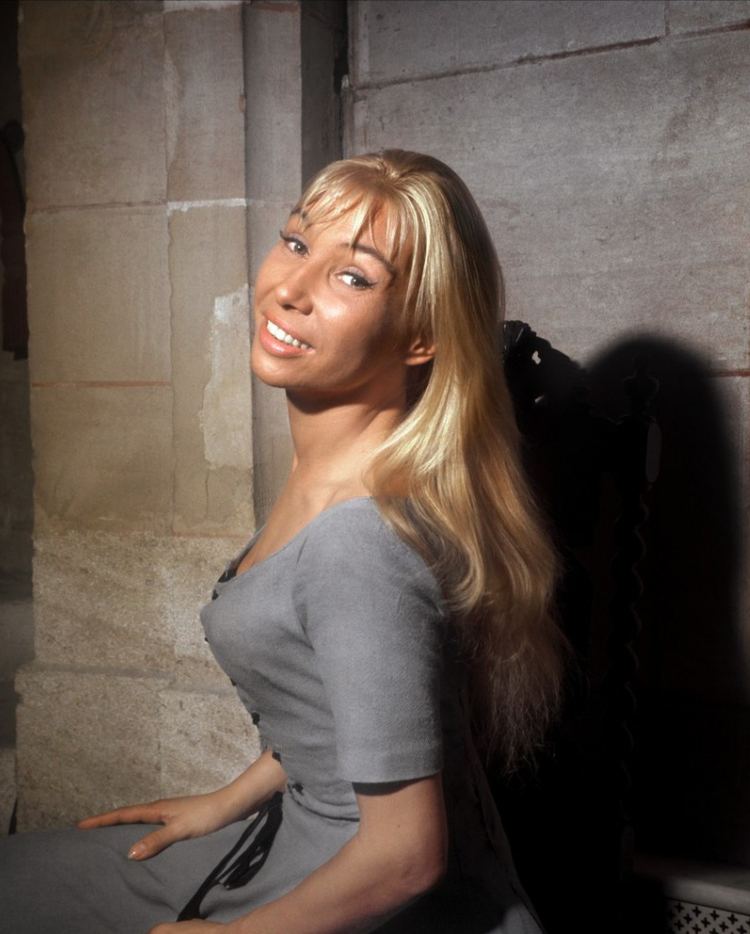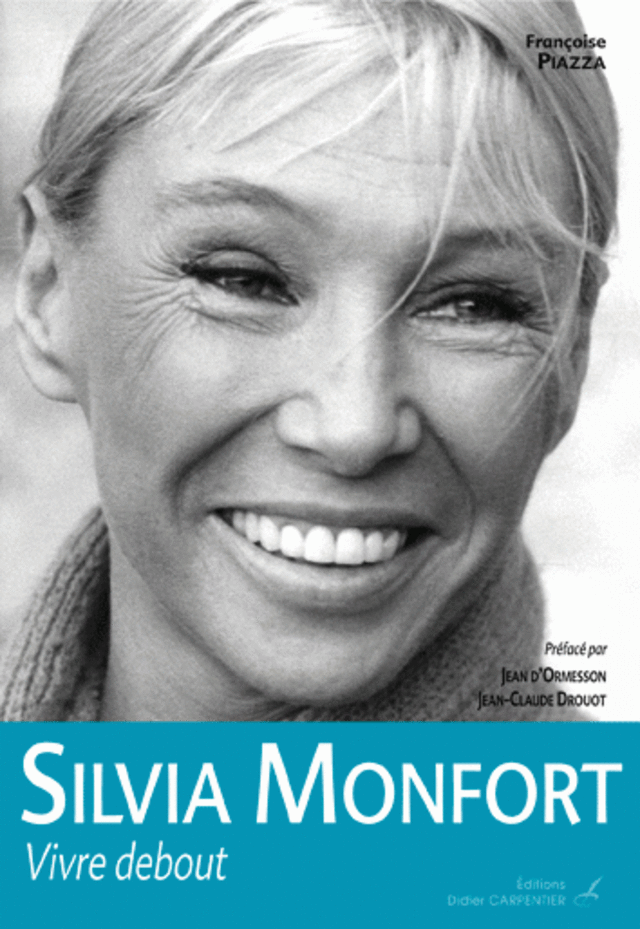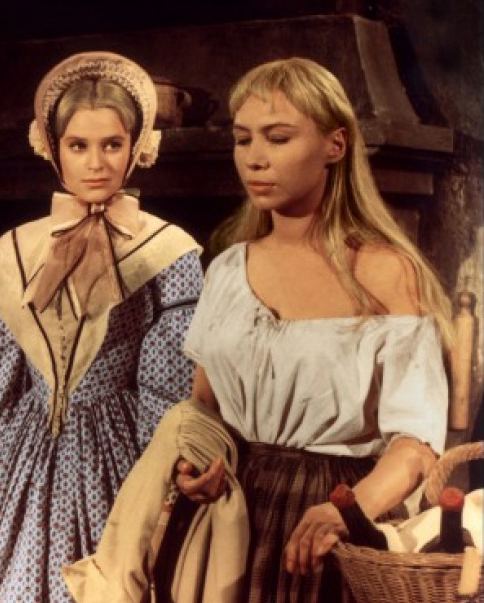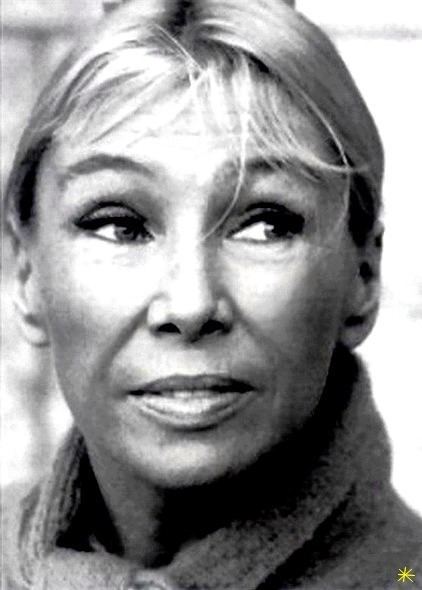Years active 1943-1986 Name Silvia Monfort | Role Actress Parents Charles Favre-Bertin | |
 | ||
Full Name Simone Marguerite Favre-Bertin Died March 30, 1991, Paris, France Movies La Pointe Courte, The Eagle with Two Heads, Rififi and the Women Similar People Jean‑Paul Le Chanois, Maurice Clavel, Alex Joffe, Agnes Varda, Claude Parent | ||
Silvia Monfort (born Simone Marguerite Favre-Bertin; 6 June 1923, Paris–30 March 1991, Paris) was a French actress and theatre director. She was the daughter of the sculptor Charles Favre-Bertin and wife of Pierre Gruneberg.
Contents
- Early life
- Cocteau Vilar and the TNP
- Cinema
- On the Road
- Tragedienne
- Phdre
- Circus and Mime School
- The Silvia Monfort Prize
- Quotations about her
- Filmography
- Theatre
- Television
- References

She was named Knight of the Legion of Honor in 1973, Officer of Arts and Letters in 1979 and then Commander of Arts and Letters in 1983. She is buried in Père Lachaise Cemetery.

Early life

Monfort was born in the neighborhood of Le Marais, on Rue Elzévir, a short distance away from Rue de Thorigny, where she would set up her first theatre much later. Her family had lived in this Parisian neighborhood for seven generations. She lost her mother very early and her father put her in a boarding school. She undertook her secondary studies first at lycée Victor Hugo and then at lycée Victor Duruy. She obtained her baccalauréat at 14 with special permission. Her father had intended for her career to be spent at the Gobelin manufactory but she preferred the theatre and took classes with Jean Hervé and Jean Valcourt. In 1939, aged 16, she met Maurice Clavel, who directed the Resistance network in Eure-et-Loir. Under the pseudonym "Sinclair" (the name of a hill that looms over Sète), she participated in the liberation of Nogent-le-Rotrou and of Chartres in 1944. She was one of the notables who welcomed General De Gaulle on the square in front of the Cathedral of Chartres. Once the war ended, she married Maurice Clavel. She was decorated with the Croix de guerre by General De Gaulle and with the Bronze Star by General Patton.
Cocteau, Vilar and the TNP

In 1945, she attracted notice for her acting in a play by Federico García Lorca, La casa de Bernarda Alba. Her personality drew the attention of Edwige Feuillère, whose reader she became in L'Aigle à deux têtes by Jean Cocteau. The play was first presented in 1946 at the Royal Theatre of the Galeries Royales of Saint-Hubert in Brussels, where she met with great success. After performances in Lyon, the play had its Parisian premiere at the Théâtre Hébertot, followed by performances at La Fenice in Venice.
Through Clavel, she met Jean Vilar in 1947 and participated in the Théâtre National Populaire. She took part in the first festival d'Avignon, with The Story of Tobias and Sarah (1947). Alongside Gérard Philipe, she played Chimène in Le Cid, then performed at Chaillot and subsequently on tour across Europe (1954). Next, she played with Vilar in Cinna and in The Marriage of Figaro.
Cinema
Monfort made her film debut in Les Anges du péché'. Director Robert Bresson had hired her without knowing that she was an actress, as he was looking for non-professionals for his film.. In 1948, she played the role of Édith de Berg in the cinematic adaptation of L'Aigle à deux têtes by Cocteau with Feuillère and Jean Marais.
In 1955, Agnès Varda, then a photographer at the TNP, directed her first film, one of the first belonging to the New Wave. Varda remembers Silvia Monfort in La Pointe Courte: "Curious and a pioneer by nature, she threw herself into the project with delight and discipline. I really think she was happy to fight for a cinema of the future."
Separated from Maurice Clavel, Silvia Monfort shared her life with and participated in the films of director Jean-Paul Le Chanois. Despite her having an arm in a plaster cast, he insisted that she play a Polish prisoner with François Périer and Pierre Fresnay in a film inspired by a true story, Les Évadés. She then co-starred with Jean Gabin and Nicole Courcel in Le Cas du docteur Laurent, a film advocating painless childbirth (1957), and then in an obscure film of Le Chanois dealing with parent-child relations, Par-dessus le mur (1961). In two films dealing with social conditions, she was Eponine of Les Misérables, alongside Gabin and Bourvil (1958), and then the Gypsy girl Myrtille in Mandrin, bandit gentilhomme beside Georges Rivière and Georges Wilson. This film concluded her cinematic career and her relationship with Le Chanois in 1962.
On the Road
During the 1960s, Silvia Monfort was passionate about cultural decentralization and so set out on the road with Jean Danet and her Tréteaux de France. She took an active part in this experiment, seeing to it that new and contemporary plays were staged alternately with the classical repertoire. On 23 June 1965, Silvia wrote to Pierre Gruneberg: "I've convinced Danet to schedule for September a series of performances of the Prostitute and of Suddenly, Last Summer under a big top around Paris (in this way the inconvenient returning directors will be able to come see it there if they need to). Oh, I would have done what I could."
She wrote at least once, sometimes several times a day to her companion Pierre Gruneberg. In the collection of this correspondence, Letters to Pierre, Danielle Netter, assistant director, adds: "The Tréteaux de France was an extraordinary theatrical tool that gave us the occasion to present Sophocles and other dramatic poets before the tenants of the HLM, and one evening to hear a spectator declare at the end of Electra to Silvia, It's as beautiful as a Western!, which filled our tragedienne with joy."
Tragedienne
For nearly half a century, whether with the Tréteaux, in festivals, in private theatres and later in her Carrés, Monfort explored the ancient and modern theatrical repertoires. She acted in no less than five versions of Phèdre in different theatres as well as on television. She interpreted numerous works of Racine and Corneille. She performed Sophocles' Electra in the most incongruous of places, such as the "trou des Halles" in Paris in 1970.
She acted in the plays and theatrical adaptations of Maurice Clavel, such as The Isle of Goats and The Noon Terrace. She was directed by Roger Planchon at Villeurbanne in 1959 in Love's Second Surprise and by Luchino Visconti in Paris in 1961 in 'Tis Pity She's a Whore beside Alain Delon and Romy Schneider. She made appearances in Summer and Smoke (1953) and Suddenly, Last Summer (1965) by Tennessee Williams. She incarnated the Sphinx of Cocteau's The Infernal Machine in festivals as well as on television with Claude Giraud in 1963. She was The Respectful Prostitute of Jean-Paul Sartre (1965) as well as The Duchess of Malfi beside Raf Vallone (1981).
At Carré Thorigny, she brought about the debut of Bernard Giraudeau in Tom Eyen's Why Doesn't Anna's Dress Want to Come off (1974). She was also seen in The Oresteia (1962) and The Persians of Aeschylus (1984). She portrayed Lucrezia Borgia of Victor Hugo (1975), Marguerite de Bourgogne of The Tower of Nesle by Alexandre Dumas, père (1986), Alarica in The Evil Is Spreading (1963), Maid of Jacques Audiberti (1971), Ethel in The Rosenbergs Should Not Die (1968) by Alain Decaux. She took on Ionesco with Jacques, or the Submission (1971), When We Dead Awaken' by Henrik Ibsen (1976) and then The Lady from the Sea' (1977). To celebrate the centenary of Cocteau's birth, she appeared for the last time on the Vaugirard stage in 'The Two Ways' in 1989.
In 1972, Monfort described her favorite roles: "Gérard Philippe, whose Chimène I was, had a habit of replying that his favorite role was his next. For me, the one that I am playing fulfills me. Imagine! What marvelous relations between an actor and his character. They see each other every day, but they also know that it's not forever, so they have to work twice as hard. Certain characters have more of an affinity for us. I have always felt myself closer to adolescents thirsting for the absolute than to women with divided hearts. I prefer Electra to Clytemnestra. I was wildly in love with Alarica from The Evil Is Spreading, Éponine from Les Misérables and recently The Maid by Audiberti. But this doesn't prevent me from knowing beautiful stories about those whom I wouldn't play. Of all the heroines, the one who perhaps excited me most was the queen of the Amazons, Penthesilea. When she thought herself defeated by Achilles, she refused to follow him into his kingdom. She wanted him to be king in her land. So she tore him up with her nails, devoured him with her teeth, and said: All women swear to their lovers: I will eat you as long as I love you – well, I did it."
Phèdre
Silvia Monfort figures among the most important performers of Phèdre. A study by the CNRS about the great tragediennes who have incarnated this character in the 20th century was published in Pour la Science, the French version of Scientific American. This study analyzed the relationship between the pauses and the versified text as well as the fluctuations in delivery and demonstrated that Silvia Monfort made the most important use of them (92% of pauses and 3.8 syllables/minute) in relation to other tragic actresses (Sarah Bernhardt, Marie Bell, Nada Strancar and Natacha Amal); this characteristic of her acting contributed to give Silvia Monfort's interpretation an exceptional quality of psychological depth and emotion.
She said of her character in 1973: "Phèdre burns in each one of us. We have hardly grasped the image in the mirror when she dims, and the imminence of this obliteration sharpens the acuteness of the reflection […] What matters is that there has been a meeting in mystery even from the first reading. It is like desire, or rather it is present in the look that provokes it, or rather there will never be unison. All the opinions, competent, imperious, singular, that were offered to me on the subject of Phèdre, and to which I listened intensely, had no other result with me than to lead me back to my Phèdre, despite her long being hazy, with the obviousness of a pawn moving back to the first square on a board game […] this is the wonder of Phèdre: to tackle it is to resign oneself to it."
Circus and Mime School
In 1972, with the support of Jacques Duhamel, then Minister of Cultural Affairs, she set up and directed the Carré Thorigny in the neighborhood of Le Marais in Paris, where she put on multidisciplinary shows. She was especially interested in the circus world and organized an exhibit entitled Circus in color which met with success. Following her contacts with circus people and her meeting with Alexis Gruss, she organized old-style circus performances in the courtyard of the Hôtel Salé, located in front of the Carré. The public's fancy led Monfort and Gruss to set up (in 1974) the first circus and mime's school in France, L'école au Carré, which they directed together. They wanted to highlight the nobility of the circus's origins and were involved in bringing to life an updated old-style circus. The Gruss circus followed Monfort in her successive moves until it became a national circus in 1982.
It was at the Carré Thorigny that Alain Decaux awarded Silvia Monfort the Legion of Honor in 1973 while paying homage to "her passion for the theatre and the inflexible will with which she serves it."
The Carré had to leave Rue de Thorigny in 1974 because of a property transaction. Monfort thus transferred her Nouveau Carré into the old théâtre de la Gaîté-Lyrique which opened on 1 October 1974 and set up the Gruss circus in the square in front of the theatre. Because of the building's awaiting renovation, she set up her stage under a big top in the Jardin d'Acclimatation from 1978 to 1979. She then had to move her big top onto the site of the former abattoirs of Vaugirard. There, she actually set up two big tops, one for theatre and one for the circus. Lacking funds, the project of renovating the Gaîté-Lyrique was abandoned.
She continued working to establish a Nouveau Carré at Vaugirard on the site of and in place of the big tops. The decision to build the theatre such as it is today was taken in 1986. On 7 March 1989, she wrote: "This will be my theatre. Even so, incredible! I don't know a single living person for whom his own theatre was built, with his name and of the right size." But she died a few months before its completion. Inaugurated in 1992, it bears her name: Théâtre Silvia-Monfort.
She died on 30 March 1991 of lung cancer in Courchevel.
The Silvia Monfort Prize
Pierre Gruneberg, who became Silvia Monfort's lover in 1963 and married her on 24 May 1990, founded the Silvia Monfort Prize Association in 1996. This prize is issued every two years to a young actress by a professional jury. Since its inception, the prizewinners have been:
- Smadi Wolfman (1996)
- Rachida Brakni (1998)
- Mona Abdel Hadi (2000)
- Isabelle Joly (2002)
- Marion Bottolier (2004)
- Gina Ndjemba (2006)
Quotations about her
Filmography
Theatre
Private theatres, TNP and Tréteaux de France
Carré Thorigny
Nouveau Carré Gaîté-Lyrique
Jardin d'Acclimatation
Carré Silvia Monfort Vaugirard
Directed by her
